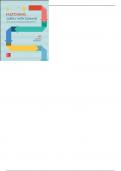Exam (elaborations)
Test Bank for Clinical Laboratory Chemistry 2nd Edition Sunheimer / All Chapters 1-26 / Full Complete
- Course
- Institution
- Book
Test Bank for Clinical Laboratory Chemistry 2nd Edition Sunheimer / All Chapters 1-26 / Full Complete
[Show more]












